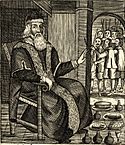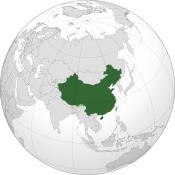World’s largest ice 'Father Christmas' built in China
Friday, December 26, 2008

The world’s largest Santa Claus ice sculpture has been built in China for the upcoming 25th International Ice and Snow Sculpture Festival in Heilongjiang Province. In Harbin, city ice sculptors and organizers are building the giant Father Christmas, a 160 meters (525 ft) long and 24 meters high sculpture. It centers on an enormous face of Santa, complete with flowing beard and hat.
Tang Guangjun, one of the sculptors, complained of the effects of global warming and hazardous conditions saying "it is even bigger and higher than last year's, and more difficult. The weather swings between warm and cold, so it becomes very wet and slippery on the ice. It is very dangerous for us." He added that "its huge size and unseasonably warm temperatures have made the job especially challenging." Organizers even have to use artificial snow.
The mid-December to early February ice festival which officially begins on January 5, has consistently increased in size over the years, with more talented artists involved and more impressive techniques and pieces on show. Ice sculpture decoration ranges from the modern technology of lasers to traditional ice lanterns. The climate of Heilongjiang is very cold and ice is plentiful. Objects of all sizes appear, up to and including building-sized pieces. In Harbin, winter temperatures can drop to below minus 35 degrees Celsius (- 31 F). According to Jia Yan, director of the local tourism bureau, about 800,000 tourists, 90 per cent of them Chinese, are expected to visit the ice festival this year.

Father Christmas or "Shengdan laoren" (literally "The Old Man of Christmas") is a name used in many English speaking countries, for the gift-bringing figure of Christmas. Although "Father Christmas" and "Santa Claus" have for all practical purposes been merged, historically the characters were different.
The symbolic personification of Christmas as a merry old figure begins in the early 17th century, in the context of resistance to Puritan criticism of observation of the Christmas feast. He is "old" because of the antiquity of the feast itself, which its defenders saw as a good old Christian custom that should be kept. Allegory was popular at the time, and so "old Christmas" was given a voice to protest his exclusion, along with the form of a rambunctious, jolly old man.
The earliest recorded personification of Christmas appears to be Ben Jonson's creation in "Christmas his Masque" dating from December 1616, in which Christmas appears "attir'd in round Hose, long Stockings, a close Doublet, a high crownd Hat with a Broach, a long thin beard, a Truncheon, little Ruffes, white shoes, his Scarffes, and Garters tyed crosse", and announces "Why Gentlemen, doe you know what you doe? ha! would you ha'kept me out? Christmas, old Christmas?" Later, in a masque by Thomas Nabbes, "The Springs Glorie" produced in 1638, "Christmas" appears as "an old reverend gentleman in furred gown and cap". The character continued to appear over the next 250 years, appearing as Sir Christmas, Lord Christmas, or Father Christmas, the last becoming the most common.
According to early Christian origins Saint Nicholas of Myra is the primary inspiration for the Christian figure of Santa Claus. He was a 4th-century Greek Christian bishop of Myra in Lycia, a province of the Byzantine Anatolia, now in Turkey.
Sisters
Sources
- "Pilgrims pray for peace" — Gulf Daily News, December 25, 2008
- Daily Mail Reporter. "Snow wonder: The amazing giant ice sculptures at China's coolest Christmas festival" — Daily Mail, December 24, 2008
- Ben Blanchard. "Let it snow: China builds "world's largest" ice Santa" — Reuters, December 24, 2008
- "China unveils 'biggest Santa'" — BBC, December 24, 2008
- Robert Appleton Company. "St. Nicholas of Myra" — Catholic Encyclopedia, February 1, 1911
- Benjamin Jonson. "Christmas, His Masque;" — Benjamin Jonson, 1640



